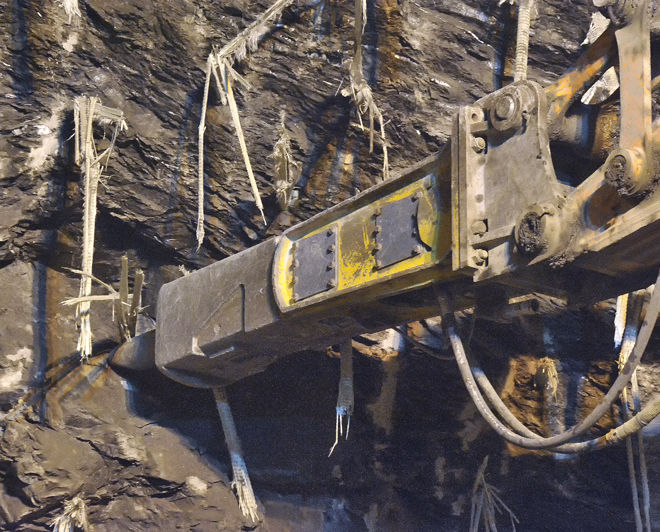A3 Highway – The Serra Rotonda Tunnel
Blasting alternated with the hydraulic breaker is a collaborative method for excavating particularly hard rock masses. Two HP 7000 have contributed significantly to the excavation of the Serra Rotonda Tunnel along the Salerno - Reggio Calabria highway.
The A3 Salerno-Reggio-Calabria highway, a non-toll road managed by ANAS (the state-owned company that constructs and maintains highways) runs a total of 442.9 km.
The road infrastructure was originally built between 1966 and 1974 in an area where road construction is a unique challenge due to the orography, geology and in certain sections levels of seismicity.
Since 2001 the A3 has been the subject of major works as part of a project encompassing both the incorporation and upgrading of the old highway and the definition of a new and parallel route. To date, 339 km have been completed with success, whereas the remaining 68.5 km are currently undergoing construction.
The Serra Rotonda Tunnel
The twin-tube tunnel of Serra Rotonda is part of the macro-lot 3 part 1 of the new route of the A3 contracted to GLF Spa. The site of the tunnel is located in the Basilicata region in proximity to the town of Lauria. The north tube measures 3,725.50 metres, plus a 135,86 metre manmade section at the north portal and a 7.10 metre manmade section at the south portal. The south tube has a total length of 3,740.00 metres plus a 128,65 manmade section at the north portal and a 7.10 metre manmade section at the south portal.
The geomechanical model
In the first circa 600 metres after the north portal, the tunnel cuts through deposits of “Lagonegro”, alternations of siliceous marl, argillite and calcilulite with poor geotechnical characteristics that give rise to settlement or subsidence on the surface. Here it was necessary to organize the work in sections in order to counter the loads. The remaining segment runs entirely within the formations of the carbonate unit of Monte Pollino, consisting of limestone and graded calcarenite and in dolomitic limestone, with maximum overburdens of about 430 metres. In the central zone, instead, the excavation cut through dolomitic limestone and dolomites that were intensely fractured indicating the presence of karts formations. The south side, where the works commenced, features limestone and calcarenite, as well as several faults, and was adjacent to the slope. From preliminary surveys performed along the route, it was verified that the water table would always be under the tunnel route. Because the geological model varied, seven different type sections studied according to the stress state of the rock mass would be used.
The excavation
Blasting and breaker were chosen for the excavation 1) due to the characteristics and lack of homogeneity of the geological model, and 2) because in the south direction both the tubes would lead out directly onto a viaduct under construction, a condition that by itself would make the TBM an unviable solution. The excavation commenced from the south entrance (Reggio Calabria side) and was carried out with the breaker in the north tube for a length of 2,424 metres, while in the south tube for a length of 2,357 metres. The rock mass did not always demonstrate levels of fracturing and hardness to permit excavation with the breaker. Specifically, the production rate (averaging 4/m/day with peaks of 6-7 m/day) progressively decreased until reaching levels below 1 metre per day, when the advancement reached the area with limestone and graded calcarenite, slightly fractured and with pronounced karst phenomena with values approximating 70 MPa. At that point it was decided to suspend use of the breaker and opt for blasting. For a short segment the production in the tube continued according to a technique that could be defined as “hybrid”, where for reasons due to the fracturing of the rock mass the blasting method failed to be completely efficient. For less than 50 metres the breaker was utilized to complete the actual excavation and profiling operations and not just scaling, while it continued to be used for the excavation of vehicle-accessible bypasses that would allow transit from the north tube to the south tube and vice versa. At metre 2,795.00S an opening was created from which Castellano SpA (subcontractor assigned to the excavation) advanced in both directions, toward Salerno and Reggio Calabria, in both tubes so as to accelerate advancement of the excavation. Castellano used the Indeco HP 7000 hydraulic breakers from the opening in the north tube for 1,156 metres, whereas blasting was selected for the rest of the segment of roughly 806 metres; from the opening in the south tube, the breaker was used for 1,064 metres, while the remaining length of 753 metres was excavated using explosives until the rock mass (featuring alternations of siliceous marl, argillite and calcilulite with poor geotechnical characteristics) required the reinforcementof the face with fiberglass subhorizontalreinforcement elements using the ADECORS system. In this area, a presence ofmethane gas was detected (already notedduring the geognostic survey), which couldhave been in enough quantities to fallwithin the stoichiometric ratio hazardousfor excavation operations (between 5 and16%). The Operations Management thenrequested the use of special excavatorsequipped with explosion-proof protections, which were provided by Technoscavi. In this case too, the subcontractor utilized Indeco HP 7000 breakers for a segment of 344 metres in the north tube and 401 metres in the south tube. Even working on material that was minimally cohesive and highly fractured, with values in some cases under 8 MPa, the breaker proved anexcellent excavation method regardless of the presence of gas, which obviously made it necessary. Blasting, when the material to be excavated is dishomogenous, highly fractured and somewhat cohesive would have delivered production rates that were too low, with preparation times, blasts and mucking that would have been nearly identical to those typical of more solid and compact rock masses. As we can see from the graphs referred to monthly production, very good production results were achieved where the use of the breaker was most intense. This was made possible by the ideal conditions created by a very fractured rock mass with RMR equal to 36 correct (CLASS IV of Beniawski), characterized by GSI values between 33 and 38 and a uniaxial compressive strength of 15-40 MPa.







